marathon VCLx#
Depending on the applets you are running on the board, you may need to enable the PoCL support via microDiagnostics. The automatic PoCL detection is disabled per default on marathon VCLx when running standard applets version 2.0 or higher, or when running individual applets created with VisualApplets version 3.0.6 or higher. When you use PoCL cameras together with such applets, you must enable automatic PoCL detection. This is possible in microDiagnostics (Framegrabber SDK version 5.5.1 or higher). For details, see Enabling PoCL Support.
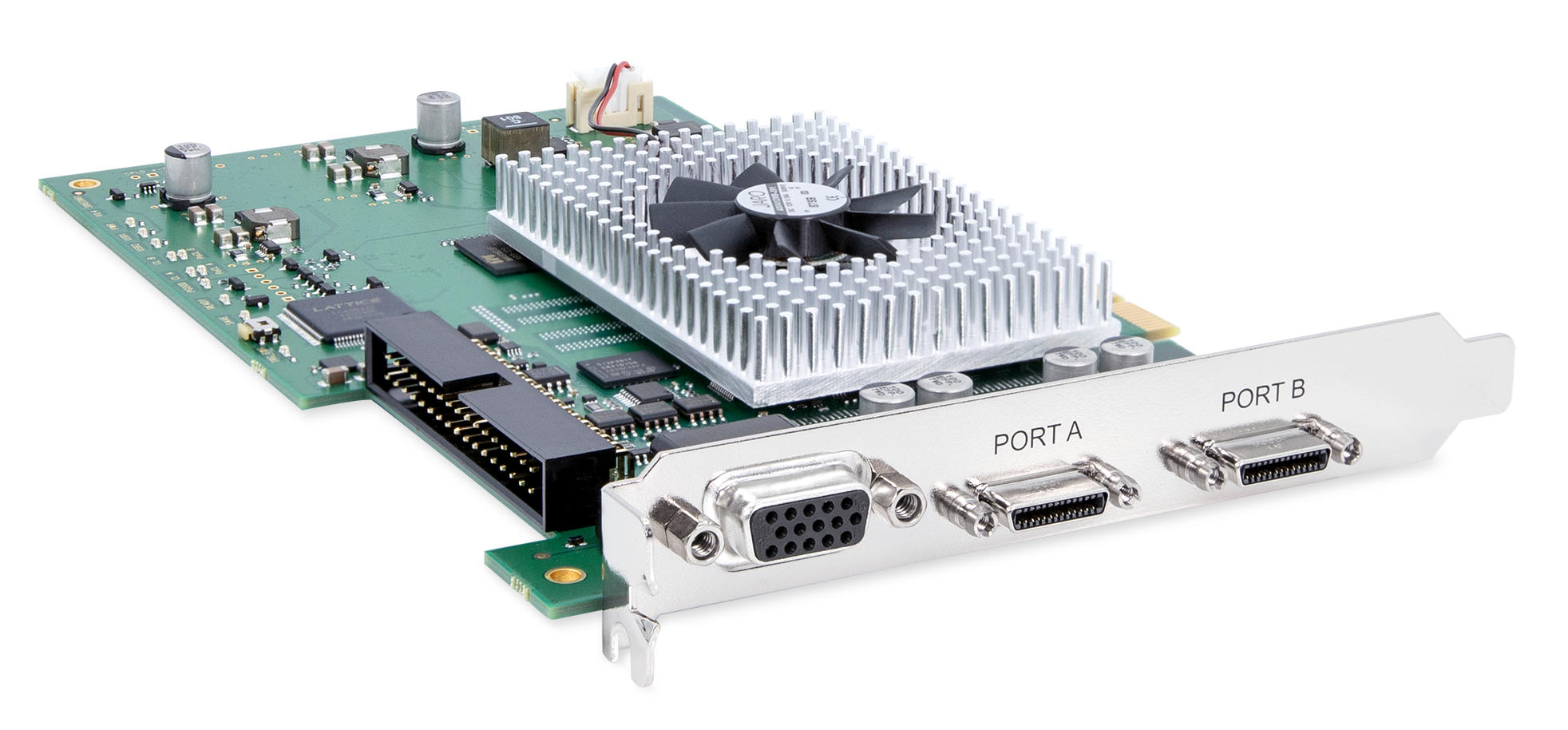
To install the marathon VCLx in your computer, plug it into a PCIe Gen. 2 x4 slot or higher. The following image shows a marathon VCLx with two Camera Link cameras connected:
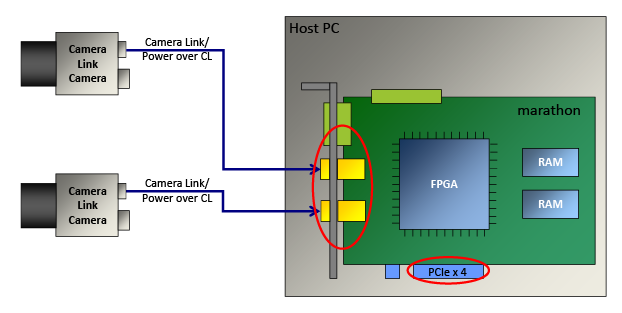
Image Processing#
In addition to the image acquisition and image processing functions that are included in the delivery, marathon VCLx can be programmed to fulfill highly specific image processing tasks that are required by a specific application. The programming can be done by Basler, a certified partner, or by yourself using the easy-to-use graphical FPGA programming environment VisualApplets.
Production Line Integration#
For integration into a production line, marathon VCLx offers multiple general purpose inputs and outputs. Depending on the hardware add-ons used, 4 to 20 GPIOs are available, also galvanically isolated.
These GPIOs enable you to do the following:
- Control peripheral devices by sending trigger signals, e.g. lighting signals and cameras signals.
- Receive various trigger signals from peripheral devices, e.g., shaft encoders and light barriers.
- Synchronize multiple marathon VCLx frame grabbers.
- Synchronize connected devices.

Communication between camera and marathon VCLx is realized via serial interface and four CC signals per Camera Link cable.
Software Programming and Configuration Interface#
marathon VCLx offers an easy-to-use API. The Framegrabber API allows to integrate the frame grabber into any image processing application. You can use the Framegrabber API to write code in the following languages:
- C/C++
- C# (wrapper available)
- Python (wrapper available)
For more information about the Framegrabber API, see the Framegrabber API documentation.
Alternatively, you can use Basler's GenTL Interface to develop your application in form of a GenTL consumer. For more information about the Basler GenTL Interface, see GenTL Interface documentation.
Connectors and LEDs#
Connectors#
marathon VCLx has the following connectors:
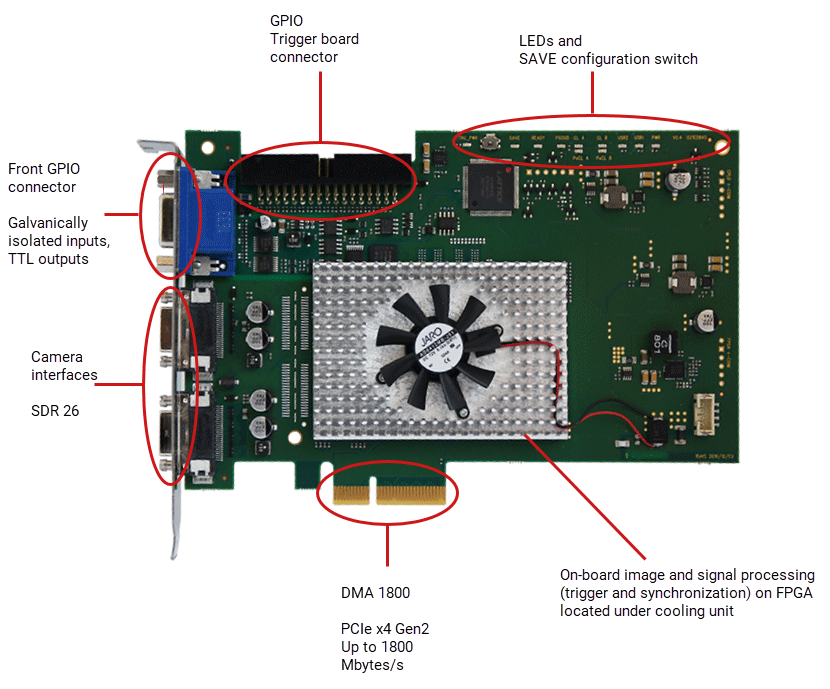
Configuration Switch#
marathon VCLx offers an on-board configuration switch for activating a fall-back FPGA configuration, called SAVE configuration. For details regarding the SAVE configuration, see FPGA Fall-Back Configuration.

LEDs on the Board#
marathon VCLx provides the following LEDs on the board:

| LED Name | LED Color | Meaning |
|---|---|---|
| TRG_PWR | Green | Front GPIO is connected to external power (power IN). |
| SAVE | RED | SAVE configuration is used for FPGA configuration |
| READY | Orange | The FPGA has been configured successfully and is ready for operation. LED READY also gives light when SAVE configuration is used on FPGA. |
| PGOOD | Orange | PGOOD=Power Good All voltages are applied correctly. |
| CL A | Orange | Port A is connected to a camera that provides a clock. |
| CL B | Orange | Port B is connected to a camera that provides a clock. |
| PoCL A | Green | Power over Camera Link active on port A: Camera on port A is provided with power by frame grabber via Camera Link cable. |
| PoCL B | Green | Power over Camera Link active on port B: Camera on port B is provided with power by frame grabber via Camera Link cable. |
| USR1 | Orange | User-defined. The LEDs can be controlled via software. They aren't related to camera connectors and can be used for any purpose. |
| USR2 | Orange | User-defined. The LEDs can be controlled via software. They aren't related to camera connectors and can be used for any purpose. |
| PWR | Green | Frame grabber gets 12 VDC IN via PCIe interface. |
Specifications#
| marathon VCLx | |
|---|---|
| Order Number | 2200000360 |
| Host Interface | PCIe Gen 2 x4 (Direct Memory Access) |
| Bandwidth (typ./max.) | Up to 1.8 GB/s sustainable data bandwidth (maximal Camera Link data rate 850 MByte/s) |
| On-Board Memory | 2 GByte DDR3-RAM |
| Power Supply (Input) / Current PCIe Slot | 12 VDC (±5 %) / <2 A (actual values depend on processing) |
| PoCXP Supply (Output) | 4 W of 12 VDC regulated power per each Camera Link connector |
| Power Consumption | Typ. current 1.4 A @12 VDC (actual values depend on processing) |
| Size (L x H) | PCIe standard height Half length card: 167.64 mm x 111.15 mm |
| Weight | 200 g |
| Camera Interface | 2 x Camera Link 2.0 standard (2 * SDR 26) (mini CL) |
| Ambient Temperature | 50 °C (0 LFMa) 60 °C (100 LFMa) An adequate airflow in the computer is recommended. |
| FPGA Operating Temperatureb | 0–85 °C at 100 LFMa |
| Storage Temperature | -50–80 °C |
| Humidity during Operation | 5–90 % non-condensing |
| Humidity during Storage | 5–95 % |
| Compliance | CE, FCC, UKCA, RoHS |
Info
The PCIe bus data throughput depends on the mainboard, the chip set, and the BIOS configuration of the host computer. The number of installed PCIe boards also affects the throughput, e.g. a PCIe x4 connector may support only x1 performance. Always check the mainboard manual thoroughly to be sure.
The Front GPIO Connector#
The front GPIO connector covers the basic trigger setup of your frame grabber. Its trigger connector allows you to control peripheral devices (PLC) and to synchronize multiple marathon VCLx boards.
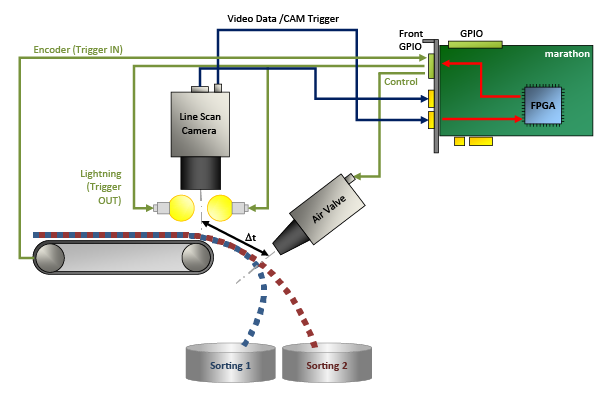
The socket is located directly on the slot bracket:
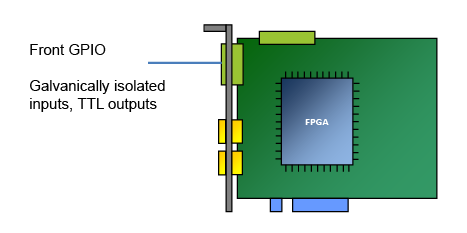
In default configuration, the trigger connector of the front GPIO connector offers:
- 3 differential input signals or 2 differential and 1 single-ended input signal in pull-up mode
- 2 TTL output signals
Info
You can configure the pin assignment of the front GPIO connector to provide different input signals, e.g.:
- Pull-down
- 4 single-ended signals (and no differential signals).
To change the GPIO configuration, use the command line tool installed with the Framegrabber SDK.
For more information, see Input Configuration and gpiotool.
Pin Layout of the Front GPIO Connector#

| PIN Number (3P FPGA) | Galvanically Isolated | Signal | Reference Signal |
|---|---|---|---|
| 1 | No | GPO 0 (TTL) | 5 VDC / global GND (pin 6) |
| 2 | No | GPO 1 (TTL) | 5 VDC / global GND (pin 6) |
| 3 | No | Reserved for RS 485 (GND) | |
| 4 | No | Reserved for RS 485 | |
| 5 | No | — | |
| 6 | No | GND (global GND) | |
| 7 | No | 5 V_OUT (0.5 A max) | |
| 8 | Yes | GPI 2 (GPI2+ if used for differential signal) | GPI voltage IN (pin 10) / GPI GND (pin 15) |
| 9 | Yes | GPI 3 (GPI2- if used for differential signal) | GPI voltage IN (pin 10) / GPI GND (pin 15) |
| 10 | Yes | GPI voltage IN (4.5–28 VDC) | |
| 11 | Yes | GPI 0+ | GPI voltage IN (pin 10) / GPI GND (pin 15) |
| 12 | Yes | GPI 0- | GPI voltage IN (pin 10) / GPI GND (pin 15) |
| 13 | Yes | GPI 1+ | GPI voltage IN (pin 10) / GPI GND (pin 15) |
| 14 | Yes | GPI 1- | GPI voltage IN (pin 10) / GPI GND (pin 15) |
| 15 | Yes | GPI GND |
Extra Voltage IN/GND for Galvanically Isolated Circuit#
All General Purpose Inputs (GPIs) of the front GPIO connector are galvanically isolated. The incoming signals are transferred to the frame grabber via digital isolators. This way, the frame grabber is securely protected against high incoming voltages.
However, to operate the internal GPI circuits, you must connect a voltage source and ground: On pin 10, you apply the voltage (GPI voltage IN) that serves as operating voltage for the internal operational amplifiers. On pin 15, you connect the according ground (GPI GND).
Supply Voltage Required
The marathon VCLx trigger system needs to get supply voltage on the GPI Voltage IN pin (pin 10). If you want to connect devices that have no PWR pin, you must provide the power supply to the GPI Voltage IN pin (pin 10) from an external source.
Possible Topologies#
You can operate marathon VCLx as follows:
| Number of Cameras | Number of Camera Ports | Number of Frame Grabber Ports | Mode | Topology |
|---|---|---|---|---|
| 1 | 2 | 2 | Bayer Pattern | |
| 1 | 2 | 2 | Grayscale | |
| 1 | 2 | 2 | RGB | |
| 2 | 1 | 2 | Bayer Pattern | |
| 2 | 1 | 2 | Grayscale | |
| 2 | 1 | 2 | RGB |
To find out which topology you can use with which applet, refer to Choosing the Right Area Scan Applet or Choosing the Right Line Scan Applet.
Acquisition Applets#
To ensure optimum use of system resources, not all image acquisition and processing features designed for marathon VCLx are loaded onto marathon VCLx simultaneously.
Instead, Basler provides various compilations of specific image acquisition and processing features that are combined to meet the requirements of a specific application field.
Typically, an applet supports a specific camera interface standard and topology, specific image acquisition features, and possibly specific image (pre-)processing features.
Applets come in .dll files.
Refer to Acquisition Applets for marathon VCLx for more detailed information about the standard applets delivered with your frame grabber and their dependency on the topology used.
In addition to the acquisition applets that are included in the delivery, marathon VCLx can be programmed to fulfill highly specific image processing tasks that are required by a specific application. The programming can be done by Basler, a certified partner, or by yourself using the easy-to-use graphical FPGA programming environment VisualApplets.